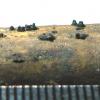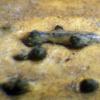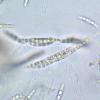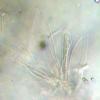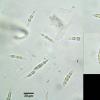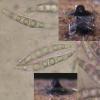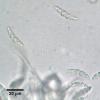
15-12-2025 15:48
 Danny Newman
Danny Newman
Melanospora cf. lagenaria on old, rotting, fallen

15-12-2025 15:54
 Johan Boonefaes
Johan Boonefaes
Unknown anamorph found on the ground in coastal sa

15-12-2025 21:11
 Hardware Tony
Hardware Tony
Small clavate hairs, negative croziers and IKI bb

15-12-2025 07:09
 Danny Newman
Danny Newman
indet. Rutstroemiaceae sp. on unk. fallen leavesMc

15-12-2025 07:05
 Danny Newman
Danny Newman
Pseudosclerococcum golindoi (det: Zotto)near Cosb

15-12-2025 11:49
 Danny Newman
Danny Newman
ITS sequences from the following two collections B

15-12-2025 12:34
 Danny Newman
Danny Newman
indet. Rhytismataceae on oak leafnear Purchase Roa

09-12-2025 12:06
 Andgelo Mombert
Andgelo Mombert
Bonjour,Je recherche l'article concernant Hypobryo
Lophio on Phragmites
Martin Bemmann,
16-07-2010 00:45
 Hi again,
Hi again,I found these today on a dead stem of Phragmites lying on the ground. Maybe the host will help to determin? Spore size is 34.6-41 x 5.3-6.8(8.4) µm. Is it Lophiostoma vagabundum again, that I found on Hedera before?
Best regards,
Martin
Hans-Otto Baral,
16-07-2010 08:41

Re:Lophio on Phragmites
I have a collection identified as Lophiostoma semiliberum, F-Deux Sèvres, Marais de Poitevin, Phalaris culms, leg. Ch. Lechat & M. Hairaud, soc. Parachnopeziza phalaridis. Perithecia immersed beneath epidermis, with a narrow projecting ostiole (round to flattened in top view). Sp. *29-36 x 5-5.4 µm, 1-septate, slightly inflated and constricted at septum, here with 0.8 µm thick gel sheath in *asci, ends without appendages or with inconsp. acute caps, old 6-septate, 37 x 5.5 µm, light grey-brown.
Apparently I identified myself, so this is not certain.
Zotto
Apparently I identified myself, so this is not certain.
Zotto
Bernard Declercq,
16-07-2010 11:17

Re:Lophio on Phragmites
I agree with Zotto.
Moreover spores of Lophiotrema vagabundum ss. str. have a thick mucous sheath while spores of Lophiostoma semiliberum have (sometimes) only small polar mucous caps.
Bernard
Moreover spores of Lophiotrema vagabundum ss. str. have a thick mucous sheath while spores of Lophiostoma semiliberum have (sometimes) only small polar mucous caps.
Bernard
Martin Bemmann,
16-07-2010 16:55

Re:Lophio on Phragmites
Hi Zotto and Bernard,
thank you for your determination! Zotto's collection and mine seem to be very similar. And what I have read now in literature (Saccardo, Migula) fits very well, too. Munk (Danish pyrenomycetes, 429) considers L. semiliberum to be unmature L. arundinis. But the clades in Zhang et al. FD 2009 seem to show that they are very close but not identical (I am not good in reading parsimony trees...).
@ Bernard: thank you also for giving me these distinguishing details. I am now even more unsure that my other find on Hedera is really L. vagabundum.
I have attached a picture of some spores of this find ((26,1)28,2-33(37,8) x 6,1-7,4(7,9) µm).
I can't remember how I came to this determination. I found it together with Unguiculella eurotioides on the same branch and I was more engaged with the latter...
Best regards,
Martin
thank you for your determination! Zotto's collection and mine seem to be very similar. And what I have read now in literature (Saccardo, Migula) fits very well, too. Munk (Danish pyrenomycetes, 429) considers L. semiliberum to be unmature L. arundinis. But the clades in Zhang et al. FD 2009 seem to show that they are very close but not identical (I am not good in reading parsimony trees...).
@ Bernard: thank you also for giving me these distinguishing details. I am now even more unsure that my other find on Hedera is really L. vagabundum.
I have attached a picture of some spores of this find ((26,1)28,2-33(37,8) x 6,1-7,4(7,9) µm).
I can't remember how I came to this determination. I found it together with Unguiculella eurotioides on the same branch and I was more engaged with the latter...
Best regards,
Martin
Hans-Otto Baral,
16-07-2010 19:49

Re:Lophio on Phragmites
There is also a record in Ascofrance by Alain, but on Urtica
http://www.ascofrance.fr/index.php?r=bdd&page=fiche&id=2350
Zotto
http://www.ascofrance.fr/index.php?r=bdd&page=fiche&id=2350
Zotto
Martin Bemmann,
16-07-2010 21:31

Re:Lophio on Phragmites
Yes I saw this docu, but are only these encircled ascocarps the questionable ones, Alain? They look like a Hysterium (joking ;-) ). But I have no experience in the variability of this genus...
Cheers,
Martin
Cheers,
Martin
